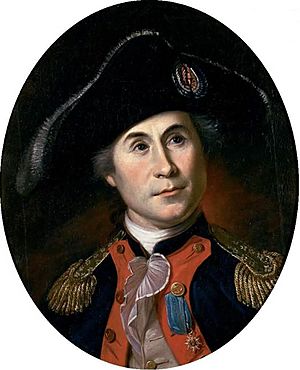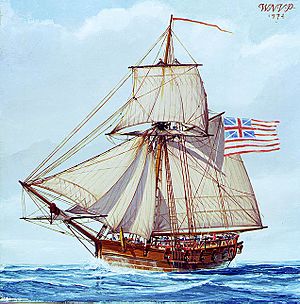Raid on Canso (1776) facts for kids
Quick facts for kids Raid on Canso (1776) |
|||||||
|---|---|---|---|---|---|---|---|
| Part of the American Revolutionary War | |||||||
 John Paul Jones |
|||||||
|
|||||||
| Belligerents | |||||||
| Commanders and leaders | |||||||
George Smith (merchant) (POW) |
|||||||
| Strength | |||||||
| 2 brigs | Approximately 15 fishing vessels | ||||||
| Casualties and losses | |||||||
| None | 1st attack: 3 vessels burned, 1 sunk, 5 prizes, 1 shallop confiscated; 2nd attack: 6 prizes, 1 burned, 1 confiscated | ||||||
The Raid on Canso was an attack that happened during the American Revolutionary War. It took place between September 22 and November 22, 1776. During this raid, an American naval captain named John Paul Jones attacked Canso. Canso is a town in Nova Scotia, which is now part of Canada. He also attacked nearby fishing villages.
Contents
Why the Raid Happened
American Attacks on Nova Scotia
During the American Revolution, Americans often attacked Nova Scotia. They came by land and by sea. American ships called privateers caused a lot of damage. Privateers were private ships that were allowed by their government to attack enemy ships. These ships raided many towns along the coast. For example, they attacked Liverpool and Annapolis Royal many times.
Earlier Raids by George Washington's Troops
Before the Canso raid, George Washington's soldiers also attacked the area. His group, called the Marblehead Regiment, raided Charlottetown. Charlottetown is now in Prince Edward Island. This happened on November 17, 1775. Just three days later, on November 20, they also raided Canso Harbor.
The Canso Raid Events
First Attack by John Paul Jones
On September 22, 1776, the American privateer John Paul Jones attacked Canso. He was sailing on a ship called the USS Providence. Jones and his crew destroyed fifteen ships. They also damaged a lot of property on the shore.
While there, Jones found new crew members. He needed them to help sail the ships he had captured. His crew burned one British fishing schooner. They sank another and captured a third. They also took a small boat called a shallop, which they used as a helper boat.
Raiding Nearby Villages
Jones then went on to attack the communities of Petit-de-Grat and Arichat. These villages are on Isle Madame. Nine ships with 300 men quickly gave up.
On the evening of September 25, a strong storm hit. It pushed three of the captured ships onto the shore, destroying them. The other captured ships were named Alexander, Kingston Packet, Success, and Defence. Jones also completely destroyed John Robin’s fishing business. His crew robbed and burned everything. John Robin did not return to his business until after the war. After this, Jones sailed to Boston.
John Paul Jones Returns to Canso
Two months later, on November 22, John Paul Jones came back to Canso. This time, he was on the USS Alfred. Boats from his ship went ashore and raided the town again. His crews burned a transport ship that was carrying supplies for Canada. They also burned a warehouse full of whale oil. They captured a small schooner. In this second attack, they took six ships, burned one, and took another.
After the raid, Captain Jones sailed to present-day Sydney, Nova Scotia. His goal was to free 300 Americans who were being held in British coalmines there.
What Happened Next
Continued Attacks on Fisheries
In 1779, American privateers attacked the Canso fisheries again. These fisheries were very important to England. They were worth $50,000 a year at that time.
Threat to Nova Scotian Ports
American privateers continued to be a danger to Nova Scotian ports. This threat lasted for the rest of the war. For example, after trying and failing to raid Chester, Nova Scotia, American privateers attacked again. They raided Lunenburg, Nova Scotia in 1782.


